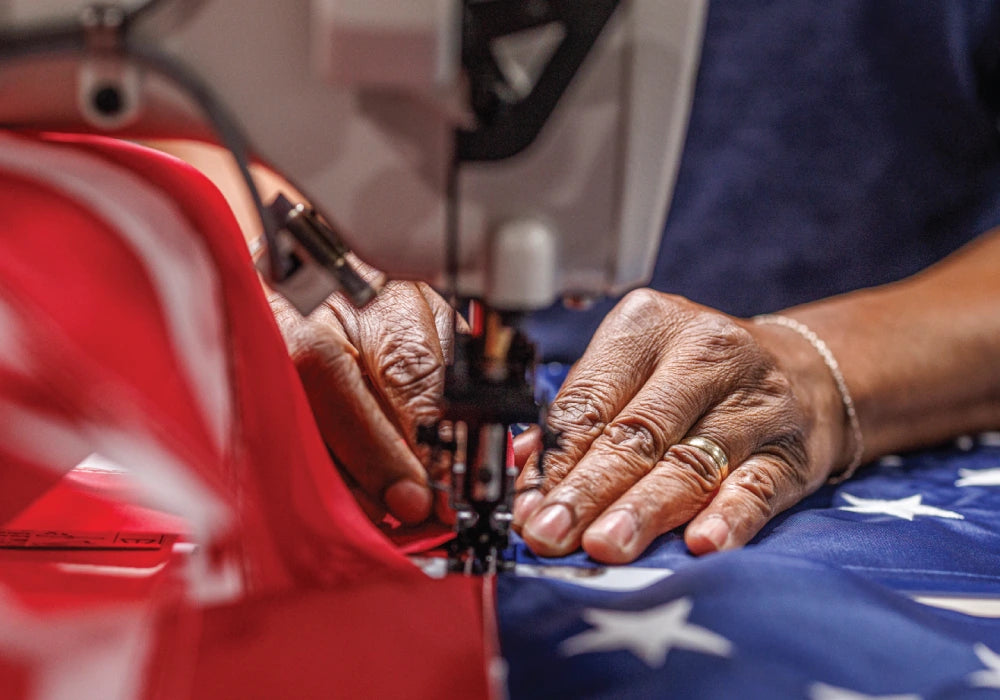Displaying the American flag on holidays and special occasions is a profound expression of national pride and respect. This tradition serves as a visual reminder of the country’s principles and the sacrifices made by its citizens. American flag protocol for holidays ensures that this emblem of liberty is displayed in a manner that reflects the nation’s values and honors its history. Engaging in this practice connects individuals from all walks of life, celebrating their shared heritage and commitment to the ideals the flag represents.

The Importance of Proper Flag Display
Understanding Flag Etiquette for Special Occasions
It involves a set of guidelines ensuring respectful and appropriate display of the American flag, especially during special occasions and holidays. These rules are more than traditional customs; they reflect our national pride and respect for the history of the United States. Whether at a private home, a public building, or during a special event, following these guidelines demonstrates a collective homage to those who have contributed to the nation’s legacy.
Historical Context of Flag Display Protocols
The traditions and protocols for displaying the American flag are grounded in historical practices that date back to the early days of the republic. Originally, the rules were created to standardize the display during military events, but over time, they have been adopted by the general public. These rules have evolved but always aim to honor the flag's representation of our nation's history, struggles, and achievements. Understanding this historical context enriches the practice of flag display and deepens the sense of responsibility to handle the flag respectfully.
Rules for Displaying an American Flag on National Holidays
Memorial Day
On Memorial Day, the American flag should be displayed at half-staff from sunrise until noon to honor the fallen soldiers who have served the United States. This specific position of the flag serves as a symbol of mourning and reflects the nation's grief as well as respect for those who have made the ultimate sacrifice. After noon, the flag is raised briskly to the top of the staff until sunset, symbolizing the nation’s resolve to rise in the face of loss and continue striving for justice and freedom.
Independence Day
This is a vibrant celebration of national sovereignty, and the flag is flown at full staff throughout the day. Displaying the American flag proudly at full staff reflects the joy and pride of the United States in its independence and the enduring values of democracy. It is not just a symbol of national pride but also a reminder of the unity and perseverance that have shaped the nation’s history. This is a day when the streets, homes, and buildings are adorned with flags, echoing the patriotic spirit of the day.
Veterans Day
Veterans Day is an important time to display the American flag to acknowledge and appreciate the sacrifices and contributions of military veterans. On this day, flags are displayed prominently at full staff across the country as a gesture of respect and gratitude. This act serves to remind the public of the courage and dedication of veterans who have served the nation in all branches of the armed forces, securing the freedoms and rights enjoyed by all Americans.
Flag Day
Observed on June 14th, Flag Day is dedicated to celebrating the history and symbolism of the American flag. This day commemorates the adoption of the flag by the Continental Congress in 1777 and is an opportunity to reflect on its significance. The proper display of the flag on Flag Day involves flying it at full staff and engaging in ceremonies that educate the public about the flag’s origins and the proper ways to show respect to this national emblem.
Proper Flag Display for Special Occasions
Parades and Ceremonies
During parades and ceremonies, the American flag should be prominently displayed either on a float or carried by an honor guard in the procession. It is customary for the flag to lead, positioned to the marching right (the flag's right) or in front of the center of a line of other flags. This placement underscores its preeminence and ensures it receives the honor and visibility it deserves during significant public events.
Patriotic Events
The American flag should always be displayed in a position of superior prominence and, when possible, above any other flag. If multiple flags are used, the U.S. flag should be hoisted first and lowered last, a protocol that symbolizes the country’s precedence and sovereignty. By doing this, the flag's prominent role as a representation of pride in national unity is guaranteed during occasions honoring American ancestry.
When and How to Fly the Flag at Half-Staff
When directed by the President or other authorized government officials, the flag should be hoisted to its peak for a moment before being lowered to the half-staff position. It’s a mark of deep respect and mourning, and it is crucial to adhere to these instructions precisely to reflect the gravity of the occasion.
Lighting the Flag When Displayed at Night
Adequate lighting not only honors the flag but also adheres to the U.S. Flag Code, which stipulates that the flag should be visible at all times when flown. Here’s an expanded look at how to effectively light the American flag during nighttime hours:
- Position Lights Carefully: It’s imperative to arrange lighting fixtures so that they fully illuminate the flag from a suitable angle, ensuring that the entire flag is visible without any parts left in shadow. This might mean using multiple lights positioned at strategic points around the flagpole. The objective is to eliminate shadows and dark spots, providing a uniform illumination that showcases the flag’s features no matter the observer's position.
- Use Appropriate Lighting Fixtures: Selecting the right lighting fixtures is crucial for optimal flag illumination. Look for fixtures specifically designed for flag lighting, such as spotlights that can focus a bright beam of light directly on the flag. Fixtures should be robust enough to withstand outdoor conditions and provide consistent performance to keep the flag well-lit every night.
- Consider Energy-Efficient Options: With environmental consciousness growing, choosing energy-efficient lighting solutions like LED lights is advisable. LEDs not only use less energy but also last longer than traditional bulbs, reducing maintenance needs and operating costs. This choice ensures the flag is illuminated effectively while also being kind to the environment and your wallet.
- Maintain the Lighting System: Regular maintenance of your lighting system is essential to ensure it remains effective. This includes cleaning the fixtures, checking for wiring issues, and replacing burnt-out bulbs promptly. A well-maintained lighting setup will prevent interruptions in illumination, which can detract from the flag’s visibility and symbolic impact.
- Adjust for Environmental Conditions: If you're in an area with frequent adverse weather conditions, such as fog, heavy rain, or snow, consider adjusting your lighting setup. Brighter lights or additional fixtures may be necessary to cut through these environmental factors, ensuring the flag remains prominently visible. This adjustment is crucial for maintaining the respect and integrity of the flag at all times.
Properly lighting the American flag at night is not just a matter of visibility; it's a tribute to the nation and what the flag represents. Ensuring that the flag is displayed with the respect it deserves, especially after dark, is a powerful gesture of patriotism and pride.

Common Mistakes in American Flag Display Rules
Avoiding Flag Contact with the Ground
A fundamental rule in how to display the American flag on holidays is ensuring that the flag does not touch the ground, floors, or water beneath it. This standard preserves the dignity and sanctity of the flag as a symbol of national pride. It is essential to handle the flag with care during raising, lowering, and transporting to prevent accidental contact, which can be seen as a sign of disrespect.
Preventing Damage from Weather
Flags displayed outside are susceptible to damage from environmental conditions. To prevent wear and tear, it is advisable to use flags made from durable, weather-resistant materials when they are flown outdoors. Additionally, it is prudent to monitor weather forecasts and lower the flag under severe weather conditions, such as heavy rain or strong winds, to extend its lifespan and maintain its respectful display.
The Proper Way to Raise and Lower the Flag
The process involves hoisting the flag briskly in the morning and lowering it slowly and respectfully at sunset. Volunteers or staff responsible for this duty should be trained in these protocols to maintain consistency and honor the flag appropriately.
How to Correctly Fold the American Flag
Correctly folding the American flag is an integral part of its care and storage, symbolizing unity and respect for the nation. The traditional triangle fold is not only practical for storage but also holds symbolic significance, representing the hat worn by Revolutionary War soldiers, which itself symbolizes freedom and the sacrifices made for it. Here’s a guide to folding the American flag correctly:
- Start with Two People: Properly folding the American flag is a two-person task to ensure it is handled with respect and never touches the ground. Each person should stand at either end of the flag, holding it waist-high and taut, to keep it parallel to the ground. Setting up the flag this way is important because it guarantees that it will be folded with dignity.
- Fold Lengthwise: The first fold is to bring the flag lengthwise over itself to halve its size, then repeat this fold once more. Care should be taken to keep the union (the blue field with stars) on the outside. In addition to making the flag smaller for the ensuing steps, this strategy maintains the insignia in a prominent position as a mark of respect and reverence for the country.
- Begin Triangular Folds: After the lengthwise folds, the real art begins. Start at the striped end of the flag opposite the blue field. Fold the corner of the folded edge up to the open edge to form a triangle. This step is symbolic, mimicking the shape of the colonial hats worn by the patriots of the Revolutionary War, representing liberty and sacrifice.
- Continue Folding: Keep folding the flag in triangular shapes until you reach the end of the fabric. Each fold tucks the previous triangle under the next, creating a compact and respectful configuration. This method not only looks neat but ensures that the flag is stored in a manner befitting its significance.
- Finish the Fold: The final fold might require a slight adjustment to ensure the triangular folding concludes with only the blue field visible, displaying the stars against the backdrop of the night sky. Such representation emphasizes the American ideal of striving towards a more perfect union, standing united under one banner.
It’s a ritual that teaches values such as teamwork, precision, and respect, reflecting the deep reverence Americans hold for their nation and its symbols. Each step in the fold has a purpose, just as each aspect of the flag holds historical significance, making the act of folding the flag a poignant reminder of the nation’s ideals and sacrifices.
Where to Purchase American Flags and Accessories
Finding American-Made Flags Online
For those looking to buy American flag online, it's essential to choose retailers that guarantee their flags are made in the USA. American-made flags are often of higher quality and adhere strictly to the official standards of flag manufacture. Websites offering a certification or label indicating the origin of their flags ensure that customers are purchasing authentic, domestically produced flags.
Top U.S. Flag Stores
Consider those that specialize in flags for both residential and commercial purposes. These stores often offer a wide range of sizes and materials, catering to different needs, from handheld flags for parades to large banners suitable for corporate buildings. The expertise of these retailers in flag etiquette and maintenance advice can be invaluable for first-time buyers and seasoned purchasers alike, ensuring the flag's longevity and proper display.
Choosing the Right Flag for Your Display Needs
Beyond only size and material, choosing the right flag also takes the intended use and display environment into account. For instance, flags used on outdoor poles must be more durable and weather-resistant compared to those displayed indoors. When planning to get U.S. flags online, look for detailed product descriptions and reviews to guide your purchase, ensuring the flag will meet your expectations for quality and visibility.
Flagpoles and Display Accessories
In addition to flags, the appropriate hardware for displaying them is crucial. This includes poles, brackets, and lighting for the night display. Reliable flag stores offer a range of options that ensure secure and respectful flag displays. When purchasing, consider the height and material of flagpoles as well as the type of mounting that suits your property. Accessories like rotating rings or eagle ornaments can also enhance the flag's appearance while ensuring it flies correctly and respectfully.

By understanding and implementing proper flag display and maintenance techniques, everyone can contribute to a culture of respect and honor that befits the emblem of our nation. The flag is a symbol that binds diverse communities with a common thread of national identity and pride. Through mindful and respectful practices, we ensure that the flag continues to embody the enduring values and aspirations of the United States, making every display a meaningful tribute to the nation’s heritage and a beacon for its future.






